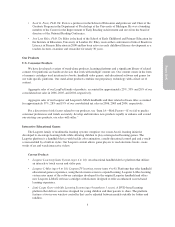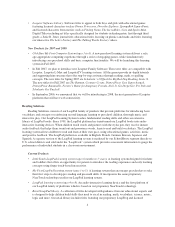LeapFrog 2006 Annual Report Download - page 19
Download and view the complete annual report
Please find page 19 of the 2006 LeapFrog annual report below. You can navigate through the pages in the report by either clicking on the pages listed below, or by using the keyword search tool below to find specific information within the annual report.particularly our new FLY Fusion Pentop Computer (available in Fall 2007) can be found at retail stores with
other electronic products, and may therefore compete with other electronic devices. Consequently, companies
like Apple Inc., Fujitsu Limited, Texas Instruments, Hewlett-Packard Company, Microsoft Corporation, Palm,
Inc., Sega Corporation and Toshiba can be considered competitors or potential competitors of LeapFrog.
Our SchoolHouse segment competes in the U.S. supplemental educational materials market. We believe the
principal competitive factors affecting the market for our products in the school market are proven educational
effectiveness, brand, features and price. Our SchoolHouse segment faces competition in the supplemental
curriculum market from major textbook publishers such as Harcourt (a division of Reed Elsevier), Houghton
Mifflin Company,McGraw-Hill, Pearson plc and Scholastic Corporation, as well as electronic educational
material and service providers such as Knowledge Adventure, Compass Learning, PLATO Learning, Inc.,
Renaissance Learning and Riverdeep Group plc.
For a discussion of the possible effect the competition could have on our business, see “Item 1A.—Risk
Factors—If we are unable to compete effectively with existing or new competitors, our sales and market share
could decline.”
Seasonality
LeapFrog’s business is highly seasonal, with our retail customers making up a large percentage of all
purchases during the back-to-school and traditional holiday seasons. Our business, being subject to these
significant seasonal fluctuations, generally realizes the majority of our net sales and any of our net income during
the third and fourth calendar quarters. These seasonal purchasing patterns and production lead times cause risk to
our business associated with the under production of popular items and over production of items that do not
match consumer demand. In addition, we have seen our customers managing their inventories more stringently,
requiring us to ship products closer to the time they expect to sell to consumers, increasing our risk to meet the
demand for specific products at peak demand times, or adversely impacting our own inventory levels by the need
to pre-build products to meet the demand.
For more information, see “Item 7—Management’s Discussion and Analysis of Financial Condition and
Result of Operations —Seasonality and Quarterly Results of Operations” and “Item 1A.—Risk Factors—Our
business is seasonal, and therefore our annual operating results depend, in large part, on sales relating to the brief
holiday season.” And “—If we do not maintain sufficient inventory levels or if we are unable to deliver our
product to our customers in sufficient quantities, or if our inventory levels are too high, our operating results will
be adversely affected.”
Employees
As of December 31, 2006, we had 916 full-time employees. We also retain independent contractors to
provide various services, primarily in connection with our content development. We are not subject to any
collective bargaining agreements and we believe that our relationship with our employees is good. In the third
quarter of 2006, we reorganized our company to create four product groups: Reading Solutions, Interactive
Educational Games, FLY and Grade School and Infant / Toddler / Preschool. There was little impact on
headcount as a result of this organization. In the fourth quarter we restructured our SchoolHouse segment to
focus our sales and product development resources on reading curriculum for core grade levels and to better align
it with our consumer strategy. With these changes we expect the segment to have a positive earnings contribution
in 2007. This restructuring led to termination of 59 full-time employees in the SchoolHouse segment. For more
information about our workforce reduction and employees see “Item 7.—Management’s Discussion and Analysis
of Financial Condition and Results of Operations—Business Update” and “Item 1A.—Risk Factors—We depend
on key personnel, and we may not be able to retain, hire and integrate sufficient qualified personnel to maintain
and expand our business.”
12
























